
Do you have a question about the Vermont Castings Defiant 1910 and is the answer not in the manual?
| Category | Wood Stove |
|---|---|
| Manufacturer | Vermont Castings |
| Model | Defiant 1910 |
| Maximum Log Length | 24 inches |
| Fuel Type | Wood |
| Flue Size | 6 inches |
| BTU Output | 55, 000 BTU/hr |
Crucial safety warning regarding installation, operation, and maintenance to prevent fire and injury.
Information about the company's commitment to customer satisfaction and dealer network.
Highlights installation, operation, and maintenance information for the Defiant Model 1910.
Lists the main sections and appendices of the manual for user reference.
Lists optional accessories available for the Defiant stove.
Provides detailed physical dimensions of the Defiant Model 1910 stove.
Discusses the need for adequate air supply for combustion in modern homes.
Explains how altitude affects chimney performance and recommended heights.
Details approved masonry/prefabricated types and size compatibility for optimal draft.
Provides rules for single-wall connectors, including material, placement, and run limitations.
Instructions for securely connecting the stove's connector to a prefabricated chimney system.
Details on passing connectors through walls and using thimbles for freestanding masonry chimneys.
Guidance for connecting to chimneys above fireplace openings.
Approved methods for passing connectors through combustible walls in the US.
Canadian standards for passing connectors through combustible walls.
Details specific floor protector dimensions required in the US and Canada.
Specific floor protection needs when installing the stove with a fireplace.
General principles for keeping combustibles away from the stove and connector.
Explains how wall shields can reduce required clearance distances.
Details the use of the rear heat shield for reducing rear wall clearance.
Instructions for installing the griddle handle and preparing the stove.
Steps for installing the ash door and bottom heat shields.
Guidance on adjusting leg levelers, damper handle, and air thermostat handle.
Identifies and explains the function of the primary air control and damper.
Details how the primary air control affects heat output and burn duration.
Explains the two positions of the damper: open (updraft) and closed (catalytic mode).
Describes top-loading via the griddle and front-loading for adding fuel.
Warnings about operating with doors open or partially open.
Guidance on burning only natural wood and avoiding harmful materials.
How to use a thermometer to monitor stove temperature for optimal operation.
Details the function and importance of the catalytic combustor for efficient burning.
Instructions for initial break-in fires to gradually condition the cast iron.
Step-by-step guide for adding fuel to a hot stove for efficient burning.
Discusses chimney height, flue sizing, and layout's impact on stove draft.
Compares performance of masonry and steel chimneys regarding heat retention and draft.
Explains the benefits of indoor chimney placement for maintaining warmth and draft.
Details creosote formation, risks, and how good draft minimizes its buildup.
Discusses the impact of wood type, moisture content, and dry wood on performance.
Methods to test and ensure adequate chimney draft for proper stove operation.
Instructions for cleaning and touching up cast iron and porcelain enamel surfaces.
Procedures for cleaning the door glass and replacing it if broken.
Guides for adjusting the primary air shutter, damper handle, and door latches for proper function.
Procedures for inspecting the catalytic element for ash, damage, and diagnosing performance issues.
Detailed steps for removing, cleaning, and inspecting the catalytic element and secondary air probe.
Step-by-step guide for removing old gaskets and installing new ones.
Explains creosote formation, risks, and the importance of chimney cleaning.
Routine inspection and cleaning for the chimney and connector.
Annual tasks including glass, gaskets, and paint touch-ups.
Explains chemical reactions, temperature requirements, and catalyst limitations.
Details problems like blockage, flame impingement, overfiring, and damage.
Lists common chimney problems like improper height, blockages, and deterioration.
Identifies hazards related to fireplace openings, hearth depth, and smoke shelves.
Details the duration and coverage for different stove components.
Lists conditions and actions that void the warranty.
Procedure for requesting warranty service and required information.
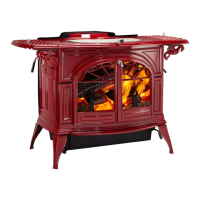

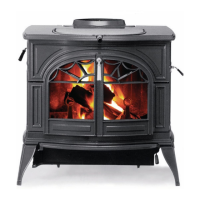
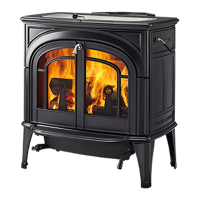
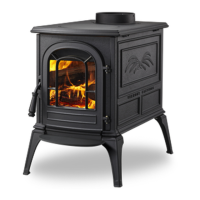
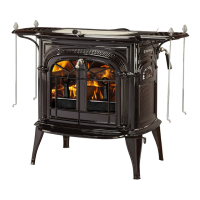
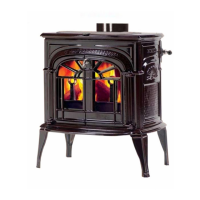
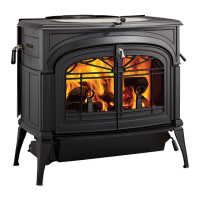
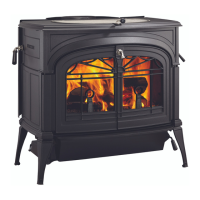

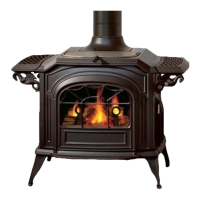
